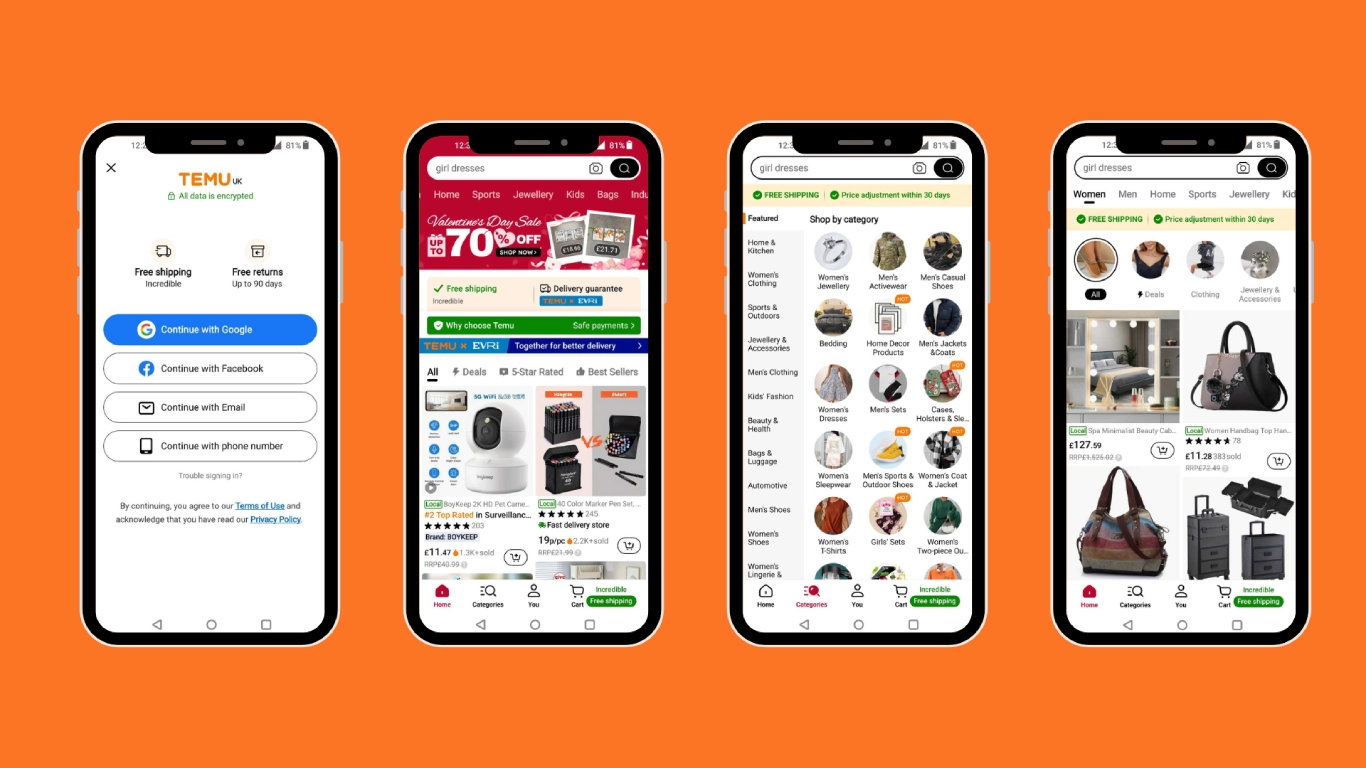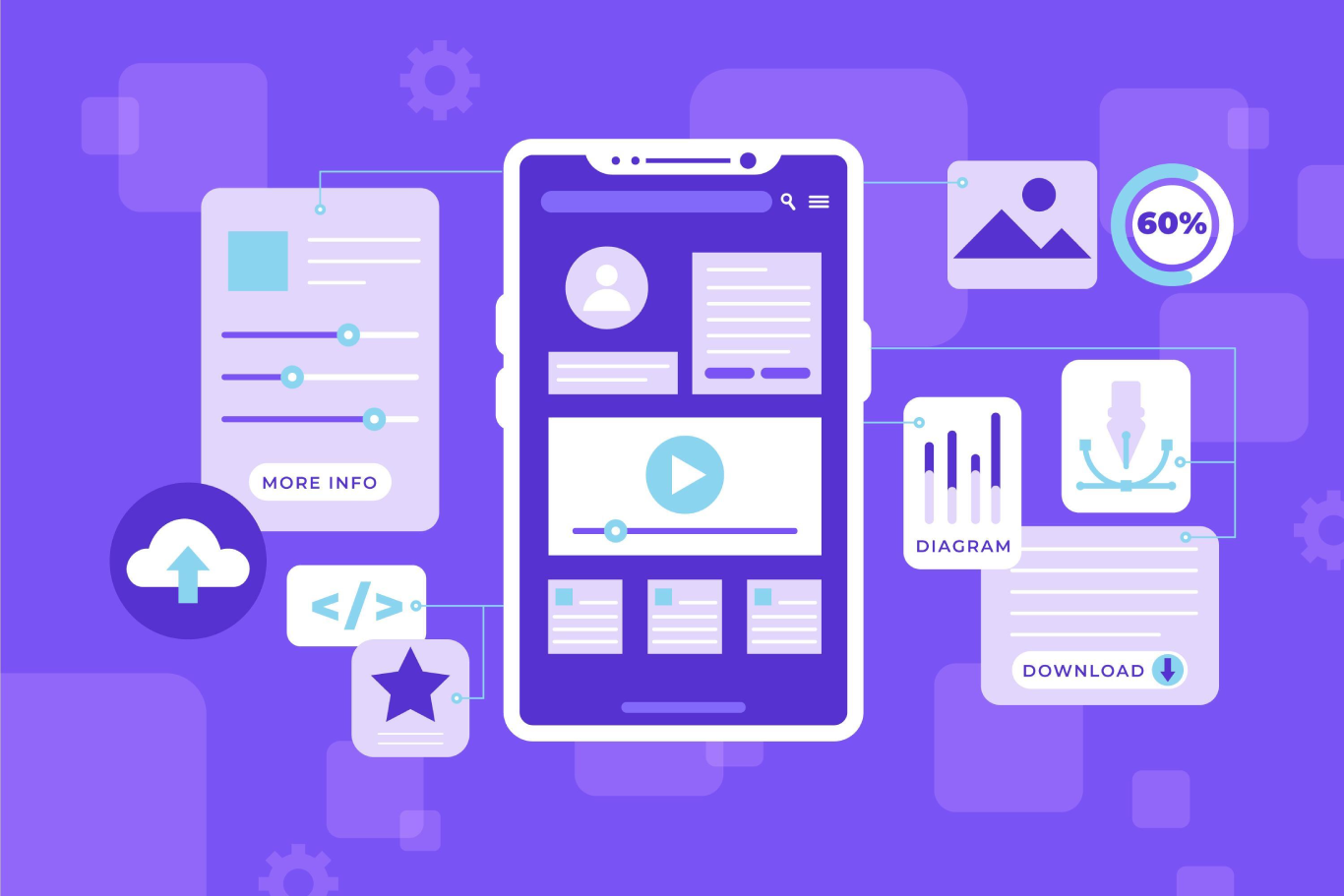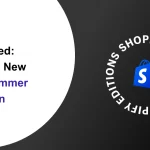
How to Build an E-commerce Mobile App Like Temu
- Anurag Pandey
- Last updated on February 18, 2025
- Android, eCommerce, iOS, Mobile Apps
- 11 minutes read
Table of Contents
ToggleIn today’s fast-paced technology-driven world, mobile e-commerce apps have changed the shopping experience for users, making it more convenient and accessible than ever before.
Platforms like Temu have set a high standard in the mobile app development industry, combining a user-friendly design, advanced features, and smooth performance.
Temu is a perfect example for businesses looking to build e-commerce mobile apps that deliver exceptional user experiences.
If you are an e-commerce business owner planning to develop a mobile app like Temu, this blog is your ultimate guide.
In this blog, you will learn everything from the best tech stack for e-commerce mobile apps to essential features, development practices, and the cost to develop e-commerce app.
Let’s build e-commerce mobile app for your ecommerce business!

Step-by-step guide on how to build an e-commerce app like Temu
Follow the detailed steps outlined below to learn how to build an e-commerce mobile app like Temu:
Step 1: Understand the features of successful eCommerce mobile apps
For every business owner starting an e-commerce mobile app requires careful planning and implementation of features that fulfill user preferences while maintaining functionality.
Some of the best key features of successful e-commerce mobile apps:
1. User Accounts: Your ecommerce mobile app must provide secure registration and login options.
You can use social media sign-ins and implement user authentication for mobile apps with options like two-factor authentication for better security.
2. Product Listings: You need to showcase products with high-quality images, detailed descriptions, pricing, reviews, and stock status.
You can make the product catalog easy to navigate with clear categories and filters.
3. Search and Filtering: In every ecommerce mobile app, users should be able to search for products and filter results by categories, price, ratings, or brand, ensuring an easy shopping experience.
4. Personalized Recommendations: You must incorporate AI-driven recommendation engines to suggest products based on a user’s search history, purchases, and preferences.
In every ecommerce mobile app having personalized recommendations increases engagement and sales.
5. Shopping Cart: You need to enable users to add products to their shopping cart, modify quantities, and proceed to checkout with ease. Include features like saving carts for future use.
6. Secure Payment Gateway: Integrate payment gateway mobile solutions such as Stripe, PayPal, or Razorpay to ensure secure transactions.
You must allow multiple payment options, including credit cards, digital wallets, and UPI.
7. Order Tracking: You must provide real-time order tracking to keep users updated about the status of their purchases from shipment to delivery.
8. Push Notifications: Every eCommerce mobile app must have a feature to send notifications to users about discounts, promotions, order updates, or cart reminders to improve engagement.
9. Social Sharing: Your eCommerce mobile app must allow users to share their favorite products or completed purchases on social media platforms. This increases word-of-mouth marketing for your mobile app.
10. Customer Support: Include live chat, chatbots, or ticket systems for resolving user queries and improving customer satisfaction.

Step 2: Plan the best tech stack for e-commerce mobile apps
Your ecommerce mobile app’s tech stack will determine its functionality, mobile app performance, and scalability.
Below, I am providing an overview of the key components:
Frontend: The front-end development controls the ecommerce mobile app’s design and interactivity.
Some of the best-recommended technologies include:
- React Native: A cross-platform framework that enables fast development using a single codebase for iOS and Android. It offers reusable components and strong community support, making it cost-effective.
- Flutter: Google’s UI toolkit is known for its high quality, consistent design, and smooth performance. It uses Dart and pre-designed widgets to create visually appealing mobile apps with a native feel.
- Native options: Swift (iOS) and Kotlin/Java (Android) provide the best performance and deep device integration, making them ideal for high-performance and highly customized applications.
Backend: The backend development manages data processing and storage.
Some of the best-recommended technologies:
1. Node.js: A fast, scalable JavaScript runtime with an event-driven, non-blocking architecture, ideal for real-time apps and high-traffic websites.
2. Django: A secure, Python-based framework with built-in features for rapid development, making it perfect for scalable web applications
3. Ruby on Rails: A developer-friendly framework with a modular structure, enabling quick development and easy maintenance of web apps.
Other Tools
Below is a detailed breakdown of additional tools you can use to increase your e-commerce mobile app:
| Category | Tool/Technology | Purpose |
| Database | MongoDB, PostgreSQL | Store user data, product catalogs |
| Payment Gateway | Stripe, PayPal, Razorpay | Secure payment processing |
| Push Notifications | Firebase, OneSignal | Real-time user notifications |
| AI for Recommendations | TensorFlow, Hugging face | Personalized shopping experiences |
Step 3: Develop the UI/UX design for e-commerce applications
Design is a critical element for every website and mobile app, as it plays a key role in user engagement and satisfaction.
The success of an e-commerce mobile app largely depends on its ability to deliver an intuitive, visually appealing, and user-friendly design.
Below are the key best practices for UI/UX design for e-commerce applications to ensure an exceptional user experience:
1. Prioritize Simplicity
A clutter-free, intuitive design ensures users can easily navigate the e-commerce mobile app.
You must use clear categories, minimalistic layouts, and prominent CTAs (call-to-actions).
2. Focus on Mobile-First Design
Given the dominance of mobile users, prioritize touch-friendly navigation and mobile responsiveness design.
You can include features like swipe gestures and thumb-friendly buttons in your ecommerce mobile app to provide a mobile-first design for your users.
3. Use Design Tools
You can utilize design tools like Figma, Sketch, and Adobe XD to create interactive prototypes and wireframes.
| Tool | Purpose | Benefits |
| Figma | Collaborative design | Real-time editing, browser-based |
| Sketch | Vector graphic editor | Ideal for iOS app design |
| Adobe XD | Prototyping and wireframing | Smooth integration with Adobe CC |
💡 Related Read: You must check out the Top Website Design Trends for AI Startups in 2025!

Step 4: Build and integrate features
Building and integrating features is the most important part of the mobile app development process as these functionalities shape the user experience of your ecommerce mobile app.
Below are the key features and how to implement them in detail:
1. Authentication
User authentication for mobile apps is the foundation of security in e-commerce apps.
You must implement robust user login and registration systems using OAuth 2.0 or JWT (JSON Web Tokens) for token-based authentication.
Your mobile app allows users to log in via social media platforms, such as Facebook or Google, and offers a secure password recovery option to increase usability and trust.
2. Product Management
A smooth product management system is critical for uploading, organizing, and categorizing products.
Build a backend admin panel where ecommerce store owners can manage product details, images, pricing, inventory, and stock status in real-time features in apps.
You must ensure the database is optimized for fast retrieval of product data, especially for large-scale catalogs.
You can use the multi-vendor features so other store owners can list the product in your ecommerce mobile apps.
3. Payment Gateway
Now you need to integrate payment gateway mobile like Stripe, PayPal, or Razorpay to support multiple payment options such as credit cards, digital wallets, and UPI.
You must ensure the integration complies with PCI DSS (Payment Card Industry Data Security Standard) guidelines for handling sensitive financial information securely.
4. Personalized AI Recommendations
You can use machine learning models to implement a recommendation engine that suggests products based on user behavior, past purchases, and browsing history.
For example, you can use a platform like Hugging Face that can help to create custom product suggestions.
If you are providing personalized recommendations in your ecommerce mobile app help you to increase user engagement and conversions.
5. Real-Time Features in apps
Integrating real-time features in apps improves the overall shopping experience by providing up-to-date information.
You must implement live order tracking, which allows customers to monitor their delivery status in real-time.
Also, you can include features like dynamic inventory updates and live chat or AI chat bot for instant customer support.
You can use technologies like Firebase to implement real-time capabilities efficiently.
Step 5: Ensure scalability and security
Scalability and security are fundamental to the sustained growth and reliability of your mobile app.
Scalability: To handle a growing user base and transaction volumes, you need to adopt a scalable architecture for mobile apps using microservices.
Each module (e.g., authentication, payments) operates independently, enabling smooth scaling. Cloud platforms like AWS or Google Cloud ensure your mobile app handles traffic nails during sales or festive seasons efficiently.
Security: E-commerce mobile apps handle sensitive user data, such as personal details and payment credentials.
You can protect this with SSL encryption, role-based access control (RBAC), and regular vulnerability assessments.
You need to perform penetration tests to fix security gaps and enable data backups for recovery.
Prioritizing scalability and security builds a reliable, trustworthy platform that ensures user loyalty.
Step 6: Test the application
Testing is an important step in mobile app development to ensure your mobile app functions smoothly across various scenarios and devices.
Conducting extensive testing before launch ensures a smooth, error-free experience for your users, which is essential for long-term retention.
e-commerce app testing strategies are as follows:
1. Unit Testing: This involves testing individual components or features of the mobile app, such as the login module, product search, or checkout process.
2. Integration Testing: This testing focus is on how different modules interact with each other.
For example, optimizing the checkout process from adding items to the cart, selecting payment options, and completing the order ensures that all components work together easily.
3. Usability Testing: Usability testing ensures the mobile app’s interface is user-friendly.
By conducting user surveys or employing focus groups, you can identify areas where users might face difficulties and refine the design.
Step 7: Launch your ecommerce mobile app
After thoroughly testing your mobile app and ensuring it performs well, it’s time to launch your e-commerce mobile app.
You can launch your app on platforms like the Google Play Store and Apple App Store.
You must follow app store guidelines for metadata, promotional content, and marketing.
Step 8: Post-launch maintenance for mobile apps
Post-launch maintenance ensures your mobile app remains functional, competitive, and user-focused.
You must regularly monitor app performance, fix bugs, and roll out updates with new features or security enhancements.
You must gather user feedback and provide reliable customer support to build trust and keep your app relevant over time.
💡 Related Read: If you are looking for smarter e-commerce solutions? Explore AI-powered personalization in our blog: “AI-Powered Personalization: How Quick Commerce Apps Deliver Exactly What You Need.

Estimated timeline and cost of developing an e-commerce app like Temu
Below is a detailed table breaking down the development cost to develop e-commerce app like Temu, categorized by key features:
| Feature | Description | Estimated Cost (USD) | Development Time (Hours) | Notes |
| User Authentication | Basic email/password login and social media login | $1,500 – $2,500 | 30 – 50 | Use Firebase or AWS Cognito for quick implementation. |
| Product Listings | Basic product pages with images, descriptions, and reviews | $2,500 – $4,000 | 50 – 80 | Use a lightweight CMS or pre-built APIs to manage product data. |
| Search and Filtering | Simple search with category filters | $2,000 – $3,000 | 40 – 60 | Implement basic search; advanced AI search deferred to future updates. |
| Shopping Cart | Add/remove items, view total price | $1,500 – $2,500 | 30 – 50 | Use open-source cart solutions to minimize custom coding. |
| Payment Gateway Integration | Secure payments using Stripe or PayPal | $2,000 – $3,000 | 40 – 60 | Simplify payment options to focus on one or two providers initially. |
| Order Tracking | Basic tracking through status updates | $1,500 – $2,000 | 30 – 40 | Integrate with external APIs like AfterShip for cost efficiency. |
| Push Notifications | Alerts for discounts and order updates | $1,000 – $1,500 | 20 – 30 | Use Firebase Cloud Messaging for affordable notifications. |
| UI/UX Design | Clean, mobile-first design | $3,000 – $4,000 | 60 – 100 | Use templates for faster prototyping and development. |
| Customer Support | Live chat or FAQ integration | $1,500 – $2,000 | 30 – 50 | Use third-party tools like Intercom or Tawk.to for a live chat. |
| Testing and QA | Basic testing for functionality and responsiveness | $1,500 – $2,000 | 30 – 50 | Focus on core features, and conduct user feedback-driven updates. |
| Deployment | App Store and Google Play submission | $1,000 – $1,500 | 20 – 30 | Automate deployment and use affordable hosting services like AWS or Firebase. |
Conclusion
With proper planning, technical expertise, and a user-focused design, you can build e-commerce mobile app like Temu. Understanding the essential features of e-commerce apps will help you successfully build your e-commerce mobile app.
By following the steps mentioned above and adopting best practices for app development, you can create a mobile app that meets user expectations and stands out in the competitive market.
If you are ready to build your own e-commerce mobile app and need a reliable mobile app development partner, you can reach out to the ControlF5 team.
Our flutter expert mobile app developers and web designers can help bring your app idea to life.
Contact us now and make your e-commerce business stand out in the tech market!
Anurag Pandey
Recent Posts
Categories
Hire Developers
About us
Popular Posts
Tags
Related Articles
How to Create a High-Converting E-Commerce Store: 10-Step Guide
Just planning and building an ecommerce store is not enough. Creating a high-converting e-commerce store is equally important because every business owner’s ultimate goal is to grow their online business and drive consistent sales.
How to Build a High-Impact Grocery Mobile App Like Instamart
In today’s fast-paced digital era, every user now depends on mobile apps and they order directly from their mobile without wasting time by going to shop. Just like clothes, electronics, and more can be online as same grocery items can also be ordered with just a few taps.

Shopify Event in India: My Experience at ShopCamp Retreat!
As a Shopify agency partner and founder of ControlF5, I constantly look for opportunities to learn, grow, and connect with industry leaders. The eCommerce landscape is rapidly evolving, and staying updated with the latest trends is essential.
Sign up for our Newsletter













